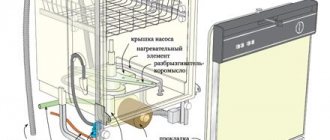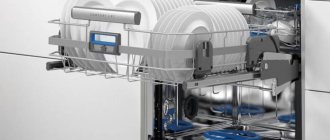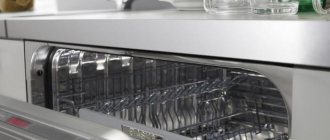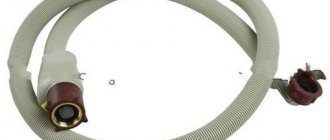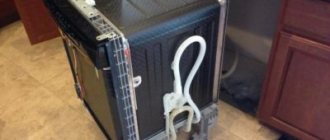Many buyers, when choosing equipment, do not pay attention to the power consumption of the dishwasher (hereinafter also referred to as PMM, dishwasher). They are more interested in the version of the PMM (built-in, free-standing or tabletop), the design and the number of dishes that the device can wash at one time.
The energy efficiency of large household appliances is improving year after year.
The electricity consumption of a dishwasher is one of the important characteristics that must be taken into account when purchasing a PMM, since utility tariffs are increasing from year to year.
Power and energy consumption: what's the difference?
Most people confuse these two indicators. In fact, there is a big difference between them. Energy consumption is the amount of energy that the dishwasher uses in one hour of operation . At the same time, individual parts of the PMM do not work continuously during this time.
For example, a tubular electric heater (hereinafter also referred to as a heating element) turns off after heating the water to the desired temperature. This will take him, for example, 10 to 15 minutes. The drain pump runs for a maximum of half an hour. At different stages of the operating cycle, different PMM nodes are involved, therefore the average energy consumption per hour of operation is determined. The calculation is carried out in kilowatt-hours (kW/h).
The energy consumption level is divided into classes - from A to G
Power is the amount of energy that the dishwasher takes from the electrical network in the event of simultaneous operation of all its components . How much electricity does a dishwasher use compared to its power? It turns out that the difference between the PMM power indicator and the energy consumption is very significant. Power is 2-3 times higher than the level of energy consumption, and its unit of measurement - kilowatt (kW) - is not tied to time . The cross-section of the electrical cable supplying electricity to the device depends precisely on the power that the dishwasher has.
Let's calculate the consumption of electricity and water
We have figured out the approximate characteristics of dishwashers, now let's do the calculations and calculate how much you will have to pay for water and electricity when using the dishwasher.
To calculate, we take the average figures for 1 kilowatt of electricity = 4 rubles. For 1 cube of cold water = 15 rubles. (mostly this is a number from 10 to 30 rubles in Russia). Let's take into account that the sink will be turned on daily.
For 1 dishwashing cycle we spend:
Dishwashers for 6 sets: For electricity - 0.62 * 4 = 2 rubles. 48 kopecks For water - 0.008 * 15 rub. = 12 kopecks Total: 2 rub. 60 kopecks
Dishwashers for 9-12 sets: For electricity - 0.95 * 4 = 3 rubles. 80 kop. For water - 0.01 * 15 rub. = 15 kopecks Total: 3 rub. 95 kopecks
For 1 month of use:
Dishwashers for 6 sets: 0.62*30 = 18.6 kW (kilowatt for 1 month) 0.008*30 = 0.24 cubic meters of water for 1 month For electricity - 18.6 * 4 = 74 rubles. 40 kopecks For water - 0.24 * 15 rubles. = 3 rub. 60 kopecks Total: 78 rubles
Dishwashers for 9-12 sets: 0.95 * 30 = 28.5 kW (kilowatt for 1 month) 0.01 * 30 = 0.3 cubic meters of water for 1 month For electricity - 28.5 * 4 = 114 rubles. For water - 0.3 * 15 rubles. = 4 rub. 50 kopecks Total: 118 rubles 50 kopecks
For 1 year of use:
Dishwashers for 6 sets: 0.62*365 = 226.3 kW (kilowatts for 1 year) 0.008*365 = 2.92 cubic meters of water for 1 year For electricity - 226.3 * 4 = 905 rubles. 20 kopecks For water - 2.92 * 15 rubles. = 43 rub. 80 kop. Total: 949 rubles
Dishwashers for 9-12 sets: 0.95*365 = 346.75 kW (kilowatt for 1 year) 0.01*365 = 3.65 cubic meters of water for 1 year For electricity - 346.75 * 4 = 1387 rubles. For water - 3.65 * 15 rubles. = 54 rub. 75 kop. Total: 1441 rubles 75 kopecks.
Electricity consumption classification
PMMs are classified not by power, but by energy consumption. All large household appliances have labels that indicate the level of energy efficiency of models of various brands - Bosch, Siemens, Electrolux and many others. The information on the tags of almost all products is systematized in the same way (see figure).
The sticker contains comprehensive information about the technical characteristics and operating efficiency of dishwashers
Interesting fact: such an indicator as power is not on the tags. There are energy efficiency classes. The most energy-efficient products are assigned classes A+++, A++, A+, and A.
Depending on the class, electricity consumption increases as follows:
- A+++ – 0.63 kW/h and less;
- A++ – from 0.65 to 0.75 kW/h;
- A+ – from 0.75 to 0.85 kW/h;
- A – from 0.85 to 1.05 kW/h;
- B – around 1.05–1.2 kW/h;
- C – in the range of 1.2–1.5 kW/h;
- D, E – from 1.5 to 2.3 kW/h.
Information about classes F and G is no longer relevant today. Most buyers choose products with classes from A to A+++.
The most economical models
There are a large number of dishwashers on sale that have low energy consumption. The most popular are:
- Electrolux ESL94510LO.
- Bosch Serie 6 SPV63m50.
- Indesit Disr57h96Z.
- Candy CDP2l952W.
- Gorenje GS52010S.
All of them have a set of functions, the use of some allows you to save on the amount of energy consumed.
Electrolux ESL94510LO
The Electrolux ESL 94510 LO dishwasher model has the lowest energy consumption. The features of this proposal include the following:
- There are 4 operating modes to choose from.
- The connection power is 1.8 kW.
- Power consumption 0.63 kW.
- The amount of water consumed per cycle is 7 liters.
Despite the low performance, the model copes well with the task.
Indesit DISR57h96Z
The model for 10 place settings with electronic control belongs to class A++. The noise level during operation is 46 dB. Key qualities are as follows:
- Energy consumption per cycle is 0.74 kW.
- One cycle consumes 9 liters.
The dishwasher is equipped with various additional functions.
Bosch Serie 6 SPV63m50
The Bosch brand produces a large number of different models of dishwashers. Serie 6 SPV 63m50 belongs to built-in appliances. Main characteristics:
- Water consumption 8 l.
- Electricity consumption 0.72 kW.
- Noise level during operation: 44 dB.
- Complete protection against leaks.
Bosch has developed a special heating technology using heat exchangers. It allows you to significantly reduce energy costs.
Candy CDP2l952W
The Candy CDP 2l952 W floor-standing dishwasher consumes 9 liters of water in one cycle. It should be taken into account that the noise level is 52 dB.
The use of energy-saving elements made it possible to reduce electricity consumption to 0.69 kW. There is partial protection against leaks, which increases the reliability of using the dishwasher.
Gorenje GS52010S
The free-standing floor-standing dishwasher Gorenje GS52010S belongs to equipment class A++. Among its features are the following points:
- Electricity consumption is 0.69 kW.
- Noise level during operation: 49 dB.
- Water consumption per cycle is 9 liters.
There is a condenser drying function. The control unit is electrical, basic information is displayed on the display.
The power of household appliances is the main criterion for its selection. A decrease in indicator does not always cause a decrease in efficiency and functionality. Manufacturers are constantly working to develop energy saving technologies. The use of these methods allows you to reduce energy costs.
What components and parts affect energy consumption?
Each dishwasher consists of a certain set of components and parts. They all consume a certain amount of energy. The level of its consumption depends on the following components:
- The heating element is the most energy-consuming element. The power of this device that heats water for washing dishes varies widely and can exceed 2 kW. Its operating time depends on the water temperature level that is set in the selected program. The temperature range is quite wide - from +30...35 ℃ to +70...80 ℃. PMM models with forced drying have another heater that increases the air temperature, as well as a fan. Unlike devices with convection drying, such dishwashers have a higher energy consumption level.
- Circulation pump - pumps liquid into the nozzles of the spray arms, and also ensures the reuse of water in order to save it. The power of this pump is low, approximately 100 W. The longer the dishwashing program lasts, the more energy the appliance consumes.
- Drain pump - pushes waste fluid into the sewer. Pump power – from 30 to 40 W. The duration of its operation depends on the amount of dirty water that needs to be removed from the PMM.
Dishwasher drain and circulation pumps (bottom view)
Energy consumption indicators depend on several other factors:
- The amount of liquid consumed per washing cycle. The indicator ranges from 7-15 liters. The more water, the longer it needs to be heated. The operating time of the drain pump also depends on the volume of water.
- Duration of the washing process. The time depends on the program selected by the user and varies widely - from 40 minutes to 4 hours. This indicator affects the total energy consumption of the circulation pump.
- Basket sizes. This indicator determines the number of tableware that can be washed in one cycle, and affects all others. If we compare narrow and full-size PMMs, the latter will require more water to operate, as well as a more powerful electric heater and pump for sprinklers. The units of small tabletop dishwashers have the lowest energy consumption and power.
The countertop dishwasher is the least productive, but the most economical of all types of PMM
How else can you save on utility bills?
It is also possible to save energy consumed by PM under certain operating conditions. Below are tips to help you reduce your costs.
- Electricity tariffs in some regions may vary depending on the time of day. If you wash dishes at night, you will pay less for electricity at the end of the month. Buy dishwashers with a “delayed start” function, which will allow the appliance to start working on its own at the right time.
- Take care of your equipment regularly: clean the heating elements from scale. Deposits on the heating elements cause the dishwasher to spend more energy heating.
- Pre-soak dishes with dried mud.
- If the dishes are not very dirty, then wash them in the machine at a temperature of 300. This is quite enough to wash off food residues and at the same time save a lot of energy on heating water.
- Buy a PM with a built-in heat exchanger - a container that allows you to save thermal energy inside the machine itself and heat the water faster the next time you start it.
- Don't start PM for the sake of two or three plates or mugs. Accumulate dirty dishes, soak them in the machine before washing them, and then wash them as a whole set. In this regard, dishwashers with a half-load mode are very convenient, which allows you to spend electricity and water for washing dishes in proportion to the amount inside. In models without this function, the amount of dishes loaded into the chamber will not matter: the same amount of water and electricity will be consumed as with a full load.
Watch also a useful video on caring for and loading PM:
Source: remont-volot.ru
Useful tips for using dishwashers
If you properly allocate resources and operating time of the dishwasher, you can save energy. Follow the recommendations below:
- Wash dishes at night when electricity rates are lower. To do this, you need to have a two-tariff electric meter and a PMM, which has a delayed start function. In the evening, turn on the device, select a washing program, start it and wait until the water in the tank finishes filling. Then stop the program and enable delayed start. Firstly, in the time before restarting, the water will have time to warm up to room temperature and less energy will be needed to heat it up. Secondly, the work cycle will be performed at night, when the electricity tariff is lower.
- Don't keep dishes dirty for too long , as dried food waste makes them more difficult to clean. You will have to run a program with soaking, double rinsing and washing at a higher temperature. Naturally, such a choice will lead to more energy consumed.
- Choose your washing program wisely - do not wash slightly soiled dishes with hot water for too long. For effective cleaning, an accelerated mode at a liquid temperature of +30...40 ℃ may be sufficient.
- Try to load the dishwasher as much as possible . Running a partially loaded PMM is impractical due to inefficient use of electricity. But if your model has a half-load function, use it.
- Regularly descale the heating element of your dishwasher. If the heater is covered with a layer of scale, it heats the water much worse, while consuming the same power as before.
Today, stores offer a wide selection of dishwashers for any family. When choosing, be sure to pay attention to energy efficiency rating labels - this will save you from unnecessary costs when paying bills in the future. You will find tips on choosing dishwashing equipment in our other article.
Saving tips
To save on using a dishwasher, you should:
- Select a program that has a delayed start. Some models provide half loading. This way you can reduce water consumption by 30%.
- Use a heat exchanger. In this case, costs are reduced by 20%.
- Clean the heating element from scale. This should be done once every two weeks. It can be done more often if plaque accumulates quickly. Mineral deposits reduce heating efficiency. The device operates at high speed and consumes a lot of energy. You can use special filters that reduce hardness. After all, if you use the device with scale inside, its service life will be shortened.
- Choose economical modes. This applies to cases where you need to wash a small amount of dishes. Then less water and energy are consumed.
Subscribe to TechnoCouncil on social networks so you don’t miss anything:
Typical malfunctions of Electrolux dishwashers
Like any technical device, dishwashers tend to break down sometimes, which is caused by stress during operation, as well as improper conditions of use and maintenance. In order to facilitate troubleshooting, the manufacturer has stored error codes corresponding to a particular breakdown in the device’s memory.
Error codes for Electrolux dishwashers
| Error code | Symptom of a malfunction | Malfunction |
| i10 | The indicator blinks once at 5 second intervals. | There is no water filling into the machine. |
| i20 | The indicator blinks twice. | There is no water drain. |
| i30 | The indicator flashes three times. | The leakage protection has activated. |
| i50 | The indicator flashes five times. | The circulation pump is faulty. |
| i60 | The indicator flashes six times. | Other reasons, including:
|
The table shows the most common types of breakdowns and their corresponding codes. Other faults and codes can be found in specialized workshops that repair household appliances.
Dishwasher repairs should only be carried out by qualified personnel.
Electrolux dishwasher repair
Repair of Electrolux dishwashers can be classified into three degrees of complexity:
- simple - which can be done independently, without the involvement of specialists, the error code is i10, and the reasons: the tap is closed or the water supply hose is squashed, and the filter installed in front of the inlet hose is clogged;
- medium complexity - can be performed on site, but this requires certain knowledge or calling a specialist. This category includes the following types of malfunctions: replacing the pump that drains water (error code - i20), cleaning filters and hoses, as well as repairing control buttons;
- complex - performed in specialized workshops by qualified personnel.
Spare parts for Electrolux dishwashers
In our country there are specialized centers that repair Electrolux brand household appliances, so if there is such a workshop nearby, then it is best to go there. In this case, the installation of original spare parts will be guaranteed and a warranty period will be provided for the work performed.
Specialized centers are the best choice when household appliances break down. In addition, original components and spare parts can be ordered through online resources; fortunately, it has its own dealers in our country, and its representative offices are in many regions.
Brief overview of the most popular models
In our country, dishwashers of the Electrolux brand are popular due to their reliability, functionality, and affordable cost. The most popular, according to user reviews, are Electrolux brand models in the following categories:
- compact, free-standing – “ESF 2400ON”;
- built-in narrow – “ESL94200LO”;
- narrow, free-standing - “ESF9453LMW”;
- full-size, free-standing – “ESF9526LOX”;
- built-in full-size – “ESL9532ILO”.
"Electrolux ESF 2400ON"
The model has a stylish design, the door and control panel are red.
This is a compact device, installed separately, equipped with leakage protection and has an energy consumption class of “A+” and overall dimensions: 438 × 550 × 500 mm (height × width × depth). Electric power – 1.18 kW. The dimensions of the working chamber allow you to place 6 standard sets of dishes. The washing mode has 6 programs, including:
- “20 Min Party Program” - “party”.
- “Eco” : temperature mode − 55°C.
- “Glass” is gentle, with a detergent temperature of 40°C.
- “Intensive” – providing maximum effect (70°C).
- “Normal” : temperature mode − 65°C.
- “Fast” - works at a washing liquid temperature of 40°C.
Electrolux ESF 2400 OK
Not all apartments have enough space even to install a narrow dishwasher. If this applies to your home, then the ESF 2400 OK could be a great option to buy. In terms of functionality, this dishwasher is practically not inferior to full-size solutions. Is that the capacity of the device is only 6 sets, and not 9 or 14.
The inner surface of the Electrolux dishwasher is made of stainless steel, and the outer surface has a black semi-matte finish. The latter requires constant care, because it can quickly collect dirt and fingerprints.
As for the set of programs, the best freestanding Electrolux dishwasher offers 6 at once: everyday, intensive, express, delicate, ECO rinse. Depending on the mode, the temperature is automatically set. Other features of the ESF 2400 OK include protection of the housing against leaks.
Advantages:
- excellent appearance;
- good washing quality;
- programs for 20 and 30 minutes;
- low water consumption;
- washes away stubborn dirt.
Flaws:
- noisier than classic models;
- Build quality depends on the item.
Electrolux ESF 2400OS
The ESF 2400 OS model closes the TOP of Electrolux dishwashers. In fact, we have before us an exact copy of the car discussed above, but in a silver color. The maximum power consumption of this dishwasher is the same 1180 W, and for a full cycle with standard settings, the device uses 0.61 kWh of energy. The Electrolux ESF 2400 OS differs from other models in the rating of dishwashers by indicating the end of the program (here it is only a sound signal).
Advantages:
- cute colors;
- many operating modes;
- moderate energy consumption;
- very fast Party mode;
- accommodates tall pans;
- There is a delay timer for a day.
Flaws:
- flimsy powder compartment latch;
- The sound notification does not turn off.
budget Electrolux ESL94200LO
This dishwasher from the manufacturer Electrolux will delight the buyer with its very affordable price. The device is fully built-in, its width is 0.45 m. At the same time, it has quite a decent capacity of nine sets.
This, perhaps, will not be enough for a large family, but for an average one it is quite enough. For washing, you can use one of five modes, although automatic is not among them. You will have to set the program manually.
The Electrolux ESL94200LO model has a very budget price, but is equipped with all the necessary functions. One of the nice additions is complete protection against leaks of the housing and hoses.
Declared washing class A. Users note that to obtain such a result, you need to learn how to properly handle the device.
The control system is electronic, but there is no display. Perhaps this is not so bad, considering that they quickly fail during voltage surges.
The advantages of the model include:
- availability of complete protection against leaks;
- possibility of adjusting the height of the basket;
- indication of the amount of rinse aid and salt;
- Removable glass holder included.
Among the negative aspects, users noted the absence of half loading and a delayed start system. In addition, the noise level is quite high, the manufacturer claims 51 dB. For this reason, operating the device at night may not be the most comfortable.
"Electrolux ESF9453LMW"
The model is equipped with sensors that monitor water flow and temperature, which allows you to optimize the duration of the washing process and, as a result, reduce the cost of electrical energy consumption. The presence of “AirDry” technology, which ensures that the door opens after completion of washing, eliminates the possibility of condensation on the inner surface of the working chamber and washed dishes.
This is a separately installed device, the placement of which will require the following dimensions - 850x446x615 mm. The dishwasher can simultaneously load 9 standard sets of dishes and process them in four temperature modes using six programs. The model has a delayed start function limited to 24 hours.

